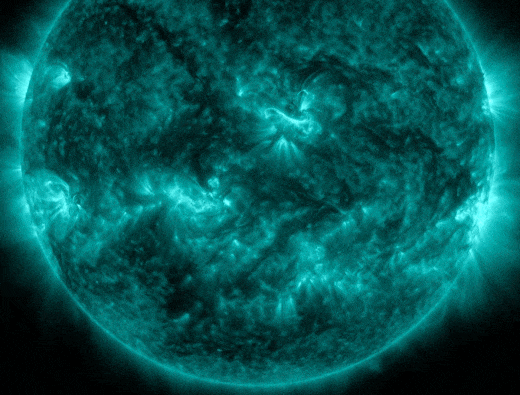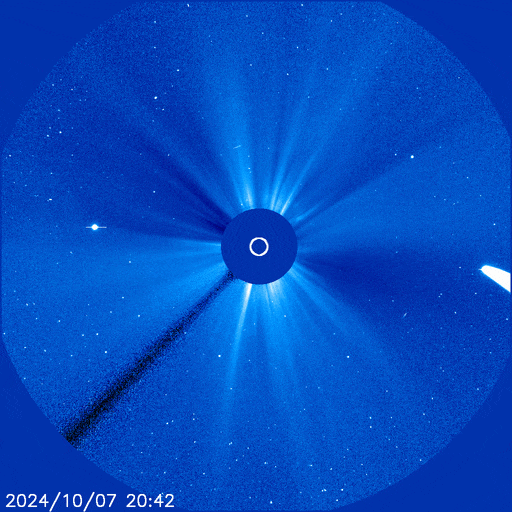2 Likes
1 Shares
Deutschlands derzeit größte schwimmende Photovoltaik-Anlage ist am Montag in Bad Schönborn (Kreis Karlsruhe) eingeweiht worden. Sie schwimmt auf dem Philippsee. Der ist knapp 60 Hektar groß. Ungefähr 15 Prozent der Seefläche sind jetzt mit schwimmenden Solarmodulen bedeckt. Das sind gut acht Hektar, also etwa zwölf Fußballfelder. Bei der Eröffnung war auch Baden-Württembergs Ministerpräsident Winfried Kretschmann (Grüne) mit dabei.
#X-ray #Solar #Flares
6-hr max: X1 1547 UT Oct09
24-hr: X1 0156 UT Oct09
https://youtube.com/watch?v=NHWKW4x3U80

#X-CLASS SOLAR #FLARE: #Sunspot AR3848 was directly facing #Earth this morning, Oct. 8th (0156 UTC), when it unleashed a powerful X1.8-class solar flare. NASA's Solar Dynamics Observatory recorded the extreme #ultraviolet #flash:
This explosions lasted more than 4 hours, so long that it lifted a massive CME out of the #sun's atmosphere. Take a look at these preliminary coronagraph images from NASA's STEREO-A spacecraft. This #CME will certainly hit Earth later this week, potentially sparking a new round of geomagnetic storms.
#X-ray #Solar #Flares
6-hr max: C8 0730 UT Oct09
24-hr: X1 0156 UT Oct09
explanation | more data
Updated: Today at: 1255 UT

#CME COULD HIT #EARTH AND #COMET T-ATLAS: SOHO coronagraphs are obtaining some remarkable images today. One of the brightest comets in decades, Comet Tsuchinshan-ATLAS (C/2023 A3), is passing through the field of view while the sun emits a series of bright CMEs. The first CME in this movie appears to be on course to hit both Earth and the comet:
Hurled into space by a powerful X2-class solar flare on Oct. 7th, the CME could strike the comet later today or perhaps early on Oct. 9th, The impact could actually rip off the comet's tail. The same thing happened to Comet Enke in April 2007. A broken tail is something astronomers should look for when Comet Tsuchinshan-ATLAS emerges from the sun's glare later this week.
According to a NASA model, the CME will graze Earth late on Oct. 9th or early on Oct. 10th. The impact could cause a another geomagnetic storm with auroras at mid-latitudes in the USA and Europe. NOAA analysts are looking at this CME now and may soon issue a refined forecast
#X-ray #Solar #Flares
6-hr max: C5 1750 UT Oct08
24-hr: X2 1913 UT Oct07
CHANCE OF MORE X-FLARES TODAY: The solar disk is filled with big sunspots. Three of them (3842, 3843, 3848) have unstable 'delta-class' magnetic fields that harbor energy for strong solar flares. NOAA forecasters estimate a 75% chence of M-class flares and a 35% chance of X-flares during the next 24 hours.
#X-ray #Solar #Flares
6-hr max: M1 0825 UT Oct05
24-hr: M1 0825 UT Oct05
explanation | more data
Updated: Today at: 1200 UT
#ANNULAR #SOLAR #ECLIPSE--TODAY: The #Moon is about to pass directly in front of the #sun, producing a 'ring of fire' solar eclipse on Oct. 2nd. The path of annularity passes almost entirely over remote parts of the Pacific Ocean:

Above: Eclipse visibility map created by Spaceweather.com reader Peter Zimnikoval
Land masses where people can see the ring of fire include Easter Island and the southern tips of Argentina and Chile. Only ~175,000 people live in the path of annularity.
Annular eclipses occur when the Moon is a little too small to cover the entire sun. All around the circumference of the Moon, the sun peeks out from behind lunar craters and mountain ranges, producing the ring-of-fire effect.
Got solar? Be a lot cooler if you did.
The U.S. #solar industry accounted for 279,447 jobs as of December 2023, marking a 5.9% increase from 2022.
Meet balkonkraftwerk, the simple technology putting solar power in the hands of renters.
Regulations limit each system to just 800 watts, enough to power a small fridge or charge a laptop, but the cumulative effect is nudging the country toward its clean energy goals while giving apartment dwellers, who make up more than half of the population, an easy way to save money and address the climate crisis.
Yep, it's really cheap and a good idea. You can get it for like 500 to 500 Euros in the supermarket
https://grist.org/buildings/how-germany-outfitted-half-a-million-balconies-with-solar-panels/
solar deployment is accelerating at breathtaking speed. Most of the world's solar power was installed in the past 30 months. In fact, China installed more solar in 2023 than the US has installed in history.
https://www.youtube.com/watch?v=EFVZwue-6tk
BUCKLE UP, another #Solar #Storm Coming and this one’s DIFFERENT 💥 MEDIA IS SILENT
The sun generates about 280 watts per cubic meter via fusion energy within its core, about the same as the human body. I could say a fusion nuclear reactor is safely powering my EV and house right now and it's perfectly legal!
#Solar power could soon become the cheapest source of electricity around the world, according new research.
Solar #energy is the most widely available energy resource on Earth, and its economic attractiveness is improving fast in a cycle of increasing investments. Here we use data-driven conditional technology and economic forecasting modelling to establish which zero carbon power sources could become dominant worldwide. We find that, due to technological trajectories set in motion by past policy, a global irreversible solar tipping point may have passed where solar energy gradually comes to dominate global electricity markets, without any further climate policies. Uncertainties arise, however, over grid stability in a renewables-dominated power system, the availability of sufficient finance in underdeveloped economies, the capacity of supply chains and political resistance from regions that lose employment. Policies resolving these barriers may be more effective than price instruments to accelerate the transition to clean energy. #ClimateChange #sustainability
